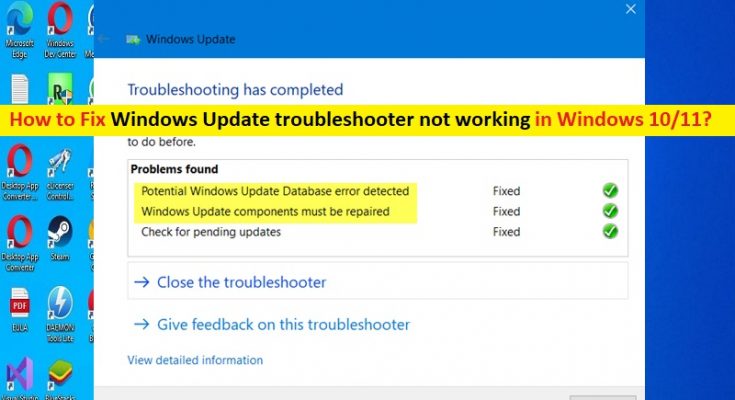What is ‘Windows Update troubleshooter not working’ issue in Windows 10/8/7 or Windows 11?
In this article, we are going to discuss on How to fix Windows Update troubleshooter not working issue in Windows 10/8/7 or Windows 11. You will be guided with easy steps/methods to resolve the issue. Let’s starts the discussion.
‘Windows Update troubleshooter’: Microsoft releases regular updates in order to protect Windows 10 system from harmful and malicious attacks. It will also update the drivers of hardware devices and improve the security features of system. It is quite simple install latest updates in Windows computer using ‘Control Panel’ app and ‘Settings’ app. However, many users are facing issues with Windows update and they experience Windows update fails to install when they attempt to install Windows Update.
To detect and fix Windows update problem, Microsoft provides you a automatic fix tool called Windows Update troubleshooter. This Windows built-in Windows Update troubleshooter runs to detect and fix Windows Update relating issue in computer. However, several users reported they faced Windows Update troubleshooter not working issue on their Windows 10/8/7 or Windows 11 computer when they tried to run Windows Update Troubleshooter. This issue indicates you are unable to run Windows Update troubleshooter in computer for some reasons.
Windows Update troubleshooter not working issue is occurred with some error codes also like 0x80070002, 0x8e5e0247, 0x80300113 and/or 0x803c010b. There could be several reasons behind the issue including the interference of third-party antivirus/firewall program installed in computer, corruption in system files and other Windows issues. It is possible to fix the issue with our instructions to do so. Let’s go for the solution.
How to fix Windows Update troubleshooter not working in Windows 10/11?
Method 1: Fix Windows Update troubleshooter not working with ‘PC Repair Tool’
‘PC Repair Tool’ is easy & quick way to find and fix BSOD errors, DLL errors, EXE errors, problems with programs/applications, malware or viruses issues, system files or registry issues, and other system issues with just few clicks.
Method 2: Uninstall third-party antivirus/firewall program

This issue can be occurred due to interference of third-party antivirus/firewall program installed in computer. You can fix the issue by uninstalling third-party antivirus/firewall in computer in order to fix the issue.
Step 1: Open ‘Control Panel’ in Windows PC via Windows Search Box and go to ‘Uninstall a Program > Programs & Features’
Step 2: Find and right-click on your third-party antivirus/firewall program, and select ‘Uninstall’ to uninstall it and after that, restart your computer and check if you can run Windows Update Troubleshooting without any issue.
Method 3: Run SFC scan
You can run SFC scan in computer to repair corruption in system files in order to fix this issue. Let’s try.
Step 1: Type ‘cmd’ in Windows Search Box and press ‘SHIFT + ENTER’ keys on keyboard to open ‘Command Prompt as Administrator’
Step 2: Type ‘sfc /scannow’ command and hit ‘Enter’ key on keyboard to execute. Once executed, restart your computer and check if the issue is resolved.
Method 4: Use Windows troubleshooting
Make sure you are following correct way to perform Windows update troubleshooter.
Step 1: Open ‘Settings’ app in Windows PC and go to ‘Update & Security > Troubleshoot’
Step 2: Find and select ‘Windows Update’ troubleshooter, and click ‘Run the troubleshooter’ button and follow on-screen instructions to finish, and check if it works for you.
Method 5: Perform System Restore

If the issue is still persist, you can perform System Restore in computer to restore your computer to valid restore point when there was no issue at all in computer.
Step 1: Press ‘Windows + R’ keys on keyboard, type ‘rstrui’ in ‘Run’ window and hit ‘Ok’ button to open ‘System Restore’ app
Step 2: Click ‘Next’, select a valid restore point according to date & time when there was no issue at all in computer, and then click ‘Next > Finish’ to start restoring process and once finished, check if the issue is resolved.
Method 6: Create a new user account
Step 1: Open ‘Settings’ app in Windows PC via Windows Search Box and go to ‘Accounts > Family & other people > Add someone else to this PC > I don’t have this person’s sign-in information > Add a user without a Microsoft Account’
Step 2: Enter the desired username and hit ‘Next’ and once created, restart your computer and login with newly created user account and check if the issue is resolved.
Conclusion
I am sure this post helped you on How to fix Windows Update troubleshooter not working in Windows 10/8/7 or Windows 11 with easy steps/methods. You can read & follow our instructions to do so. That’s all. For any suggestions or queries, please write on comment box below.



